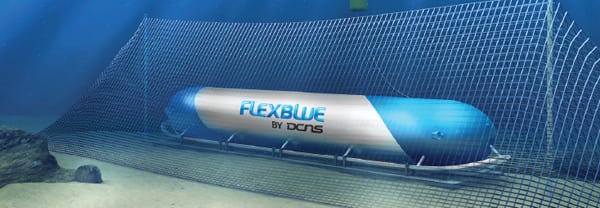Small Nuclear Reactor Concept Goes Underwater
France in January announced its contribution to the wave of small and modular reactors (SMRs): a submarine-like nuclear plant that can be submerged in waters 60 meters (m) to 100 m deep and several kilometers offshore.
French defense firm DCNS (Direction des Constructions Navales), a company that has been building submarines for the French navy for more than 40 years, unveiled its Flexblue unit, a reactor combined with a steam turbine/alternator set, that would have a capacity of between 50 MW and 250 MW.
The unit, which includes steam generators, turbines, and a generator, would be encapsulated in a 100-m-long cylinder with a diameter of 12 m to 15 m (Figure 2). It would transmit power to facilities close to shore via undersea cables.
 |
| 2. Flexible nuclear power from the deep blue sea. French defense firm DCNS in January unveiled its Flexblue concept, a deep-sea submarine-like nuclear plant that would produce and transmit power to facilities onshore via undersea cables. The unit, which is planned to have a capacity of between 50 MW and 250 MW, is encapsulated in a 100-meter-long cylinder with a diameter of 12 m to 15 m. Courtesy: DCNS |
DCNS said it has been working on the Flexblue unit for more than two years and plans to collaborate with the government, French nuclear giant AREVA, and utility Électricité de France to optimize its modularity and standardization. The collaboration has already initiated the next two-year phase of development. According to DCNS, the companies’ next steps include furthering technical research and exploring production options, including market potential. They are also working to review safety and security aspects of seafloor power plants, seeking to demonstrate that “Flexblue offers a level of safety comparable with that of third-generation land-based nuclear power plants.”
Several SMR concepts have been introduced in recent years (see “Are Small Reactors Better?” in POWER’ s November 2010 issue). Closest to the offshore concept is the 64-MW Russian surface vessel Akademik Lomonosov, which was launched from the Baltic Shipyard in St. Petersburg in July 2010.
In the U.S., the Department of Energy’s Savannah River site is exploring the possibility of hosting and testing several prototypes of small units, including Hyperion Power Generation’s Hyperion Power Module and GE Hitachi’s PRISM.
And last November, Tennessee Valley Authority (TVA) told nuclear regulators that it was considering using Babcock & Wilcox–designed mPower reactors by 2020, building them on the site of the abandoned Clinch River Breeder Reactor in Oak Ridge, Tenn. If granted a license by the Nuclear Regulatory Commission (NRC), TVA could be the first utility in the U.S. to build the reactors.
The relatively new sector has also suffered several setbacks, however. In January, it was widely reported that startup SMR developer NuScale Power was facing funding problems as the Securities and Exchange Commission filed suit against its key financier, The Michael Kenwood Group, barring it from meeting funding obligations to the company. NuScale is currently seeking other funding sources to fuel development of its project.
Nor is the sector immune to legal challenges afflicting other power generation types. The DOE Savannah River program that is testing SMR prototypes was in January charged with trying to avoid having to submit the reactors to the NRC for licenses to build them. The DOE said that it plans to engage regulators throughout all aspects of the reactors’ project development but said it had the “the authority to construct, operate and monitor safety of research reactors at its sites.” It added: “NRC regulation is not necessary unless these reactors feed electricity to a commercial grid.”
–Sonal Patel is POWER’s senior writer.